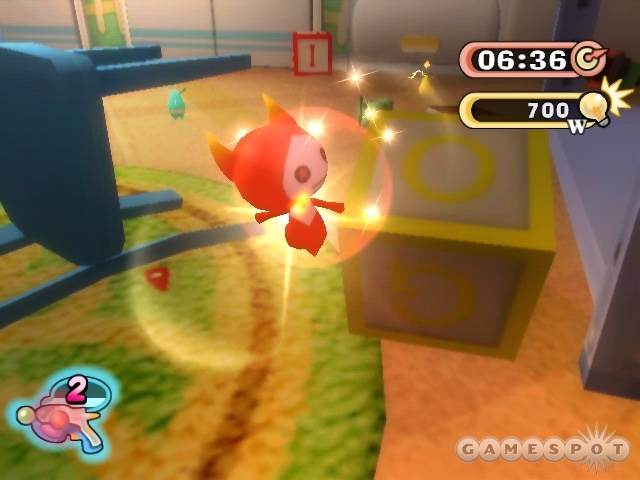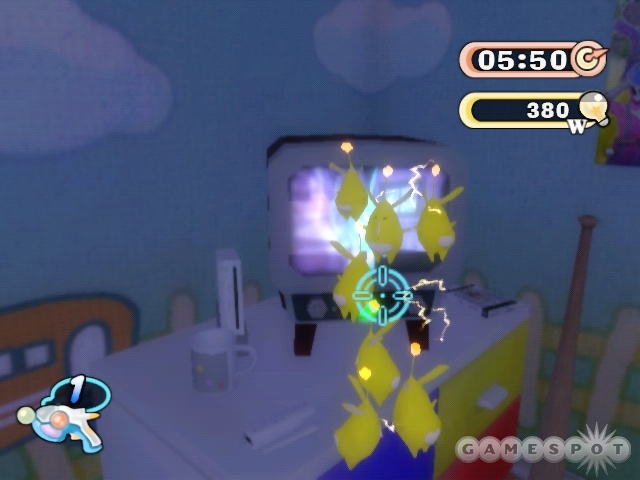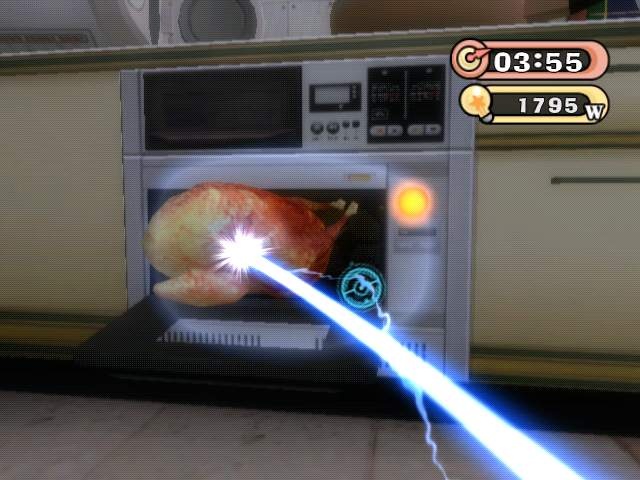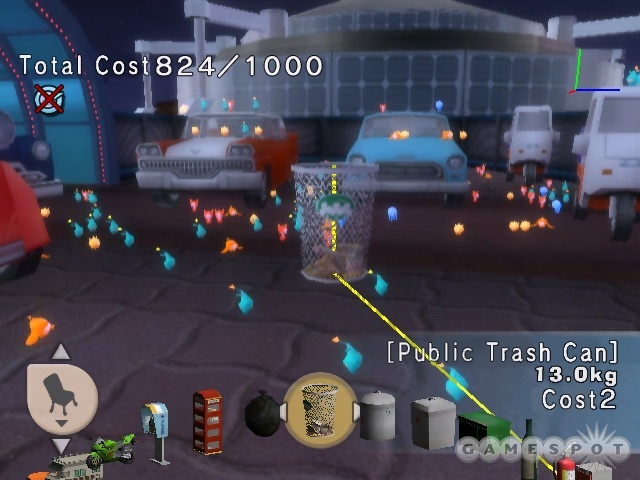If you're looking for a game that demonstrates the kinds of crazy gameplay the Wii is capable of producing with its motion sensing controls, Elebits may be right up your alley. Functionally it's a first-person shooter for younger audiences, and the goal is less to shoot and more to capture. Think of it like Ghostbusters, except that instead of ghosts, you're capturing teensy creatures called elebits. Each world in the game is littered with tons of elebits, and many of them are hiding from you. You use a unique capture gun to not only snatch up the little buggers, but also move objects around the environment. It's as though someone at Konami got hold of Half-Life 2's gravity gun and concocted a fairy tale around its technology. The result is a slightly repetitive but oddly engaging mix of shooting and puzzling that isn't challenging but is pretty fun.

You're on the hunt for the titular elebits because, according to the game's lore, elebits are the sole source of power for the world. These cute creatures give off a unique type of energy that renders nuclear power, natural gas, gasoline, coal, and just about every other power source obsolete. Evidently, the elebits are cool with us siphoning off their energy to drive cars and power lamps--at least until one fateful day, when all of the world's power shuts down after a powerful lightning strike. Enter Kai, a whiny brat whose parents happen to be some of the world's foremost elebits researchers. When the power outage occurs, Kai's parents take off to discover the cause, leaving Kai home alone. Kai's parents generally ignore him in favor of work, and he's pretty bitter about it. This event is the last straw, and Kai is determined to figure out what's going on. When he realizes that all the elebits have gone rogue, he snatches up his dad's capture gun and sets off to save the world. This story is told through some periodic bits of narration that pop up in between story missions. These scenes are done with still-frame art that looks quite nice, but the voice acting is horrendous. As if Kai weren't whiny enough through text dialogue, hearing him speak is like a needle through the eardrum. Granted, the story is rather incidental in the grand scheme of things, but there was an opportunity for some Katamari Damacy-like craziness here, and the game doesn't take advantage of it.
To recapture all those wayward elebits, you'll be using the capture gun to search through various areas around Kai's house and town. The capture gun itself is capable of lifting objects in the environment and moving them. If you notice a desk lamp or a trash can shaking a bit, that probably means there are some elebits hiding underneath. Just move around with the Nunchuk's control stick, aim your targeting reticle via the Wii Remote, press A or B to fire, and hold the button down to use the energy beam to grab hold of the object. From there, you just fling the object wherever you like and reveal those precious elebits. Once they're revealed, you fire off quick shots at them to collect them. Of course, if all you did was pick up objects, shoot tiny creatures, and repeat, the game would become monotonous extremely quickly. It's good, then, that there's a touch more strategy to it than that.
The game measures the number of elebits you collect in electrical wattage, and you need to achieve a certain number of watts to clear a stage. You're also under a time limit, ranging from five minutes to 20, depending on the level. One of the better tricks the game has is the way it forces you to not only collect overall watts, but also collect power for your gun. Certain types of elebits provide power exclusively for your capture gun, but the only way to access them is to power up certain types of appliances found in a level, like a flat-screen TV, a phone booth, or a branded Epson printer. You need to boost your gun's level to pick up heavier objects (and reveal more elebits), but you also have to hit a certain overall wattage target to be able to power up these objects, so what you end up with is a nice balancing act between achieving the main wattage target and working to level up your gun.

It's the same balancing act throughout nearly all of the game's stages, but occasionally the game throws in some seemingly arbitrary rules for certain stages, such as limiting the number of furniture pieces you can break or forcing you to keep your rampant destruction to a quieter noise level. There's not much explanation for why these rules are in place. Being loud doesn't scare off all the elebits, nor is anyone around to yell at you if you break too many vases. The rules are seemingly there to try to add some variety to the objectives, but they just get in the way.
That's mainly because the best thing about Elebits is its ability to let you run amok. This is probably the best "make a mess" simulator you've ever played--you can throw junk all over the place and lay waste to any environment. Granted, making a mess is less a priority than collecting all those cute elebits, but as you power up your gun and get the ability to pick up bigger objects, you can really have a field day, picking up cars, buildings, and just about anything that isn't nailed down in the later stages. All these objects sport full-on physics, so there isn't much you can't grab onto and throw about. Of course, those physics aren't always spot-on. There are some goofy movements to some of the larger objects in the game. Everything looks like it has the same weight and consistency to it when it hits the ground, whether it's a plate or a semitruck. Certain smaller objects break apart, but a lot of them don't. Also, having to use the capture gun beam to open doors is beyond annoying. There's just not a lot of realism to the physics, but considering the fantasy vibe the game puts off and the fact that it's more about making a silly mess than it is moving objects around realistically, it's easy to forgive the occasionally wonky physics.
As fun as the physics can be, the in-game graphics leave a lot to be desired. There's certainly a charm to the game's look--the cuteness of the worlds and the elebits--but technical performance gets in the way quite a bit. Environments are colorful, but textures look extremely drab and muddy, to the point where Elebits looks like a first-generation GameCube game. And even with these low-res visuals, the frame rate seems unable to keep up with what's going on in the game. This is less of an issue indoors, but the second you get into any of the outdoor levels, the game chunks up severely. Charm goes a long way, but not enough to forgive the one-two punch of dingy textures and bad frame rates. The voice acting is the worst part of the game's audio, but the rest of it is quite good. The soundtrack is nicely varied and features some catchy electronic tunes, and the kitten cries of the elebits as you capture them are rather cute, if a bit disturbing.

Elebits is a pretty breezy game. Since the bulk of the gameplay is hide-and-go-seek with a laser gun, the challenge is less in shooting stuff and more in simply finding all the necessary elebits. But even that isn't especially tough. Elebits don't do much to run away once they're found, and it's just a matter of pointing and shooting at them. A few elebits do attack you, but they aren't typically the collectible ones anyway, so all you really need to do is avoid them. You'll bust through the game's story mode in under six hours and fail maybe one or two stages during the entire course of the mode. This applies to the few boss fights that pop up as well, which are perhaps even easier than the normal stages. Bosses have very specific, very easily discernable patterns that become obvious right away, so they're good for little more than a quick distraction from the usual tasks.
Though the game is simple, there's an oddly compelling quality to the action. Hunting elebits becomes addictive after a while, especially once you start picking up some of the neat power-ups that let you target multiple elebits, or attract them to one spot, or vacuum them up en masse via a whirlwind that sends all the inanimate objects in close proximity into a crazed frenzy. You also have the option to go back and play any stage over again to try to achieve a higher score, and there are score attack and challenge mode options as well, which impart some new conditions on old stages.
Once you've completed the story mode, there's a four-player multiplayer mode to mess with. This mode lets you and up to three other friends go at it in a level, both competing and cooperating to catch elebits. It's a strange and screwy mode in the way it tries to balance competitive and cooperative play. Only the host player can move around, so that player is in control of what displays on the playing field, but everyone is competing to score as many watts as possible, so you basically have to both rely on and compete against the host player. It's pretty sloppy, a fact made all the more visible by how chaotic the multiplayer gets in four-player mode. It's near on impossible to see who is shooting what in this mode, and because only one player gets to move the camera around, if you get in the lead, you could feasibly just stand still in a spot where there are no more elebits to collect and wait out the timer. That's not just dumb; that's broken.

The game's edit mode is more enjoyable. This mode lets you build your own levels to play around with. You can only use the basic single-player stage designs, but within them, you can place objects and elebits just about anywhere you'd like. The system is relatively easy to use, and best of all, you can trade created levels with your friends via the WiiConnect24 system. Granted, you have to have someone's friend code in order to do anything, and there's a weird limit of one trade per day imposed, but otherwise, this is a cool addition that definitely gives the game some legs.
You'll come away from Elebits with an interesting mix of reactions. The motion controls are nicely done, and the puzzle nature of the levels can be quite addictive. But as cool as Elebits can be, it's rarely the game part of it that really stands out. Elebits' technology is what drives it--the combination of the motion controls and the hearty physics engine turns what is, in essence, a pretty simple kids' game into something greater than the sum of its parts. It's certainly not going to be for everyone, but any Wii owner on the hunt for something new and original would do well to give it a look.



